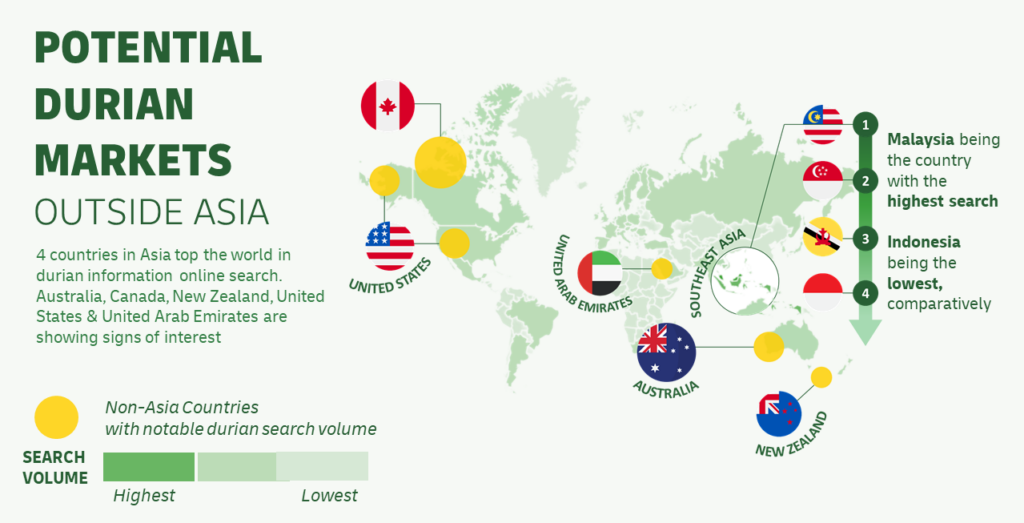Durian: the Asian king of fruits
Its shape and smell make the durian a very special fruit. However, its texture and taste have turned it into a real hit among Asian consumers and increasingly among other nationalities around the world.
You love it or you hate it: durian fruits come mostly from Southeast Asia and are dubbed the “King of Fruits” by fans. The shape of the fruit, its size and its smell generate this love-hate relationionship.
The name of the fruit is originated from a Malay word meaning thorn. The fruit has an oval greenish/yellowish shell, bristling with sharp spines. It can be as long as 40 cm and can weight up to 7kg. Once you open the fruit -it needs someone skilled for this task with gloves and a large kitchen cleaver, a pale to dark yellow flesh appears with its pulp. And here start the issue: the durian has a pungent smell which many would compare to rotting. The smell is so pugnacious that many hotels in Asia -particularly in Singapore- ban taking durian inside their compound.
However, once tasted, the fruit reveals a creamy texture, melting in the mouth with hints of caramel, apricots or almonds. The effect could be compared to some French cheese. Smelly outside, delicately flavoured once tasted.
Few countries produce durian fruits. They are all located in Southeast Asia and are commonly found in Indonesia, Malaysia, the Philippines and Thailand and on a smaller scale in Cambodia, Laos, Myanmar and Vietnam. Around Asia, China, India and Sri Lanka have seen the development of durian farms. Outside Asia, Australia, the USA (Florida and Hawaii), Guyana or Guatemala started cultivating durians more recently.
Fresh fruits in Asia, frozen pulp in the western world
The largest producers remain however in Southeast Asia. Thailand is by far the top producer with Malaysia and Indonesia. The three countries together produce over 90% of the world’s durian harvest. The largest importer is China with a total of 821,000 tonnes.

In 2021 alone, Thailand’s Ministry of Commerce reported a volume of 580,000 tonnes valued at approximately €2.2 billion that was exported to China of a total production of over 700,000 tonnes. Malaysia and Indonesia produce over 260,000 tonnes of durian every year.
The market for durians is expected to continue to grow. According to a report of consultant Mordor Intelligence, the fresh durian market value in the world was estimated at approximately €8.5 billion in 2022. It is due to reach €13.3 billion by 2028. Factors contributing to growth are tourism, cross-cultural experiences in cooking as well as health benefits of eating durian (in reasonable portions). The fruit helps to control sugar levels and reduces the risk of some cancers due to anti-oxidants, along with antidepressant and anti-aging properties.
Fresh fruits will continue to dominate Asian consumers’ markets, particularly the Monthong variety from Thailand and the Musang King variety from Malaysia. In Europe or in North America, frozen durian pulp and paste are leading with a market of 70% as durian sweets, ice creams and cakes are sold in Asian or oriental supermarkets.
Join us at SIAL Paris as exhibitor Join us at SIAL Paris as visitor
